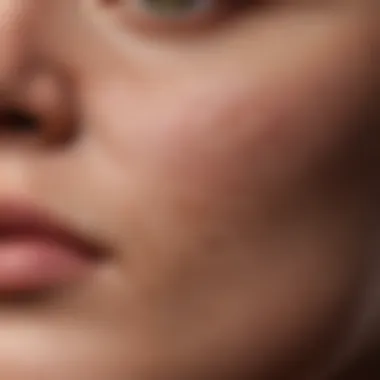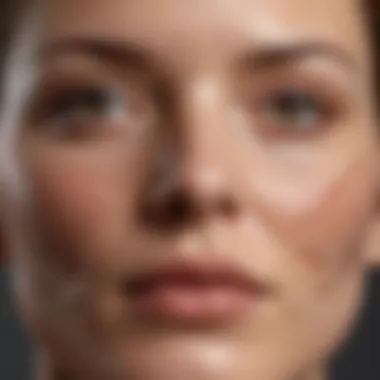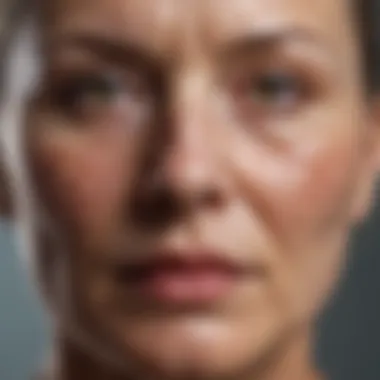Exploring the Significance of Dermal Lines on Skin


Intro
Skin lines, often referred to as dermal creases, are inescapable features of our body. They appear for various reasons, ranging from natural aging to environmental influences. Understanding these lines is crucial not just from an aesthetic viewpoint but also for health and psychological implications.
As we navigate through the complexities of human skin, we will explore the key findings related to skin lines, the methodologies behind the research, and their significant implications across various sectors. The interplay between skin lines, our environment, and our personal perceptions shapes our understanding and attitudes toward beauty and health. This article aims to shed light on these important themes, ultimately enriching our knowledge of dermatology and self-care practices.
Foreword to Skin Lines
Understanding the intricacies of skin lines is essential in comprehending the broader implications of skin health and aesthetics. These lines are not mere reflections of aging; they signify deeper physiological changes occurring within the body. With advancing age, environmental factors, and lifestyle choices, skin lines increasingly become a topic of discussion.
The importance of this topic stems from its relevance to various fields, such as dermatology, cosmeceuticals, and even psychology. Understanding skin lines requires an exploration of fundamental skin structures and the biological processes that govern skin health.
Understanding Skin Structure
To appreciate why lines form on the skin, it's crucial to grasp the basic structure of the skin itself. The skin is composed of three primary layers: the epidermis, dermis, and subcutaneous tissue.
- Epidermis: The outermost layer that acts as a barrier against environmental variables. It consists mainly of keratinocytes that continually renew themselves.
- Dermis: Beneath the epidermis, the dermis harbors collagen, elastin, blood vessels, and nerve endings, playing a vital role in elasticity and texture.
- Subcutaneous tissue: The deepest layer, containing fat cells that provide insulation and cushioning.
With age, the cellular turnover slows down, leading to thinner epidermis. This change impacts the dermis, where collagen and elastin begin to degrade, leading to the formation of lines.
The Role of Collagen and Elastin
Collagen and elastin are pivotal proteins in maintaining skin structure. Collagen provides strength and firmness, while elastin allows for flexibility and resilience. Their roles become apparent when examining skin lines:
- Collagen: This fibrous protein forms a scaffolding that supports skin's thickness. As collagen decreases with age or due to environmental stressors like UV exposure, skin loses its firmness, making lines more visible.
- Elastin: Responsible for the skin's elasticity, elastin enables the skin to return to its original shape after stretching. Insufficient elastin leads to sagging and deeper lines.
In summary, the understanding of skin structure and the roles of collagen and elastin is imperative to grasp the development and significance of skin lines. Recognizing these elements aids in not only diagnosing skin aging but also in devising effective preventive and therapeutic measures.
Types of Skin Lines
Understanding the types of skin lines is a fundamental aspect of dermatology and skincare. Each category of skin line reveals a unique story about the skin's health, aging process, and the underlying physiological conditions. The distinction between these lines is crucial, as it allows practitioners and individuals to tailor skincare routines and treatments accordingly. Recognizing these variations can lead to better preventive care and more effective solutions.
Fine Lines vs. Deep Wrinkles
Fine lines and deep wrinkles serve as indicators of skin aging and environmental stressors. Fine lines are typically shallow creases that emerge due to a loss of moisture, elasticity, and collagen in the skin. They often appear around the eyes, mouth, and forehead. Deep wrinkles, on the other hand, are more pronounced and result from prolonged exposure to damaging factors such as UV rays, smoking, and even repetitive facial movements.
Fine lines can be seen as the initial stage of wrinkle formation. They signal the onset of aging and can be managed with proper skincare products.
Deep wrinkles may require more intensive treatments like chemical peels or fillers, as they tend to be more resistant to simple remedies.
"Understanding the differences between fine lines and deep wrinkles is essential for effective skincare management."
Expression Lines and Their Origins
Expression lines stem from the movements of facial muscles. Commonly referred to as "dynamic lines," these creases are a result of repeated facial expressions, such as smiling, frowning, or squinting. Over time, these lines may become more visible, particularly in areas such as the forehead and around the eyes.
The formation of expression lines can be attributed to factors like aging and reduced skin elasticity. While they are a natural byproduct of human emotion, they can also be indicative of the body's overall skin health. Proper hydration and muscle relaxation methods, like Botox, can mitigate their appearance.
Static vs. Dynamic Lines
Static lines are evident even when facial muscles are at rest, often reflecting more advanced aging or cumulative environmental damage. Dynamic lines, in contrast, develop specifically during facial expressions and may fade when the face is relaxed.
Understanding the difference is important in choosing appropriate treatments. For instance, static lines might require more invasive approaches such as fillers or surgical options, whereas dynamic lines may respond better to topical treatments or neuromodulators.
Ultimately, being aware of how different skin lines manifest can provide invaluable insights into one’s skincare requirements and help guide discussions with healthcare professionals.


Biological Factors Influencing Skin Lines
Understanding the biological factors that influence skin lines is critical for comprehending why certain patterns appear and how they evolve over time. These factors include genetics, hormonal changes, and nutrition, all of which can significantly alter skin integrity and appearance. By exploring these components, we grasp how intrinsic elements drive the formation of lines on our skin, shedding light on the complex interplay between our biology and dermatological health.
Genetics and Skin Aging
Genetics play a vital role in the aging process of the skin. Each person's genetic makeup determines not only the speed at which skin ages but also the type and depth of lines that may form. Certain genetic traits can predispose individuals to conditions such as premature aging, where lines may appear earlier than expected.
Skin elasticity, texture, and overall resilience are influenced by hereditary factors. For instance, people with a family history of skin conditions like psoriasis or eczema may experience more pronounced skin lines due to impaired barrier functions. Age-related changes, including the decreased production of collagen and elastin, are further exacerbated by genetic predispositions.
In summary, genetics lay the foundation for how our skin ages, influencing the appearance of lines and overall dermal health.
Hormonal Changes and Skin Texture
Hormonal fluctuations significantly affect skin texture and appearance. Various life stages, such as puberty, pregnancy, and menopause, introduce surges and declines in hormone levels, primarily estrogen and testosterone. These hormones are crucial for skin vitality.
During puberty, the increased levels of hormones can cause the skin to become oily and more prone to acne. In contrast, during menopause, the depletion of estrogen may lead to dryness and reduced skin elasticity, contributing to the formation of fine lines and deeper wrinkles.
Additionally, hormonal imbalances can trigger skin sensitivities, fostering an environment that could further age the skin prematurely. This creates a cyclical pattern where hormonal changes lead to alterations in skin texture and resilience, ultimately influencing the visibility of lines.
The Impact of Nutrition on Skin Health
Nutrition has a profound impact on skin health and the appearance of lines. A well-balanced diet rich in vitamins, minerals, and antioxidants supports skin vitality. Conversely, poor dietary choices can accelerate the aging process and exacerbate skin issues.
- Vitamins C and E are powerful antioxidants, protecting skin from oxidative stress caused by environmental factors.
- Omega fatty acids, found in fish and nuts, nourish the skin and support its structural integrity.
- Hydration plays a key role in maintaining skin moisture, reducing the appearance of fine lines.
A deficiency in essential nutrients can also impair the skin’s ability to repair itself, making it more susceptible to damage and, consequently, to the development of lines.
Environmental Influence on Skin Lines
The environmental influence on skin lines is a critical aspect of understanding the overall health and appearance of skin. Various external factors play a role in how skin ages and shows the signs of wear. Identifying these elements is crucial for both preventive care and treatment strategies. Recognizing how the external environment impacts skin can lead to informed decisions regarding skin health and beauty practices.
Sun Exposure and UV Damage
Sun exposure is one of the leading causes of skin lines. Ultraviolet (UV) radiation from the sun penetrates the skin, leading to damage that manifest as fine lines or deeper wrinkles. The intensity of UV rays varies based on geographical location and season. When skin is repeatedly exposed to these rays without adequate protection, it can accelerate the aging process.
- UV rays have two primary types that affect the skin:
- UVA rays penetrate deeply and cause long-term skin damage, contributing to early aging.
- UVB rays primarily affect the surface, causing sunburns.
To mitigate these effects, using broad-spectrum sunscreen is advised. Regular application can prevent long-term damage and is a key step in maintaining skin health.
Pollution and Its Effects on Skin Integrity
Environmental pollution is another significant factor affecting skin integrity. Daily exposure to pollutants can lead to oxidative stress, which damages skin cells. The pollutants can include particulate matter, vehicle emissions, and industrial output, all of which infiltrate the skin, accelerating the formation of skin lines. The following points illustrate how pollution affects the skin:
- Causes inflammation and irritation, leading to premature aging.
- Alters skin moisture levels, ultimately impacting elasticity.
- Contributes to the formation of free radicals that degrade collagen and elastin fibers.
Using antioxidant-rich products can help neutralize these harmful effects. Cleansing the skin properly to remove pollutants is equally important.
Climate and Skin Elasticity
Different climates can also affect the elasticity of the skin. For example, extremely dry or humid conditions can exacerbate the appearance of skin lines. In arid climates, the lack of moisture can lead to dehydrated skin, resulting in fine lines. Conversely, high humidity can increase oil production, which may lead to clogged pores and subsequent skin issues.
Factors that influence skin in varying climates include:


- Temperature fluctuations can affect blood circulation in the skin.
- Humidity levels play a role in maintaining skin moisture.
- Seasonal changes necessitate different skincare routines for optimal skin health.
Understanding how climate affects skin elasticity helps in crafting personalized skincare regimens tailored to specific environmental conditions.
The environment, encompassing sun exposure, pollution, and climate, fundamentally shapes the appearance and health of our skin over time.
Psychological and Cultural Perspectives
The exploration of psychological and cultural perspectives surrounding skin lines is crucial. This section reveals how perceptions of skin aging affect individuals' self-esteem and identity. It also embraces a wider cultural lens, highlighting variations in skin care approaches across different societies.
Societal Views on Skin Aging
Societal views on skin aging shape the frameworks within which individuals interpret their own skin lines. In many cultures, youthful skin is synonymous with beauty and vitality. Conversely, aging skin may be regarded with negative connotations. This can create pressure, especially for women, to maintain a youthful appearance. Promotions of cosmetic products often emphasize the reduction of lines, creating a perception that smooth skin equates to success and desirability.
The impact of these societal views can lead to profound psychological consequences. Some individuals may experience anxiety or depression linked to their skin appearance. This discontent can manifest in various ways, from obsessive skincare routines to a reliance on cosmetic procedures. However, there is an emerging appreciation for authenticity and natural beauty, prompting a slow shift in attitudes. People are increasingly recognizing the wisdom and experience that come with age, often celebrating their skin as a map of their life journey.
The Psychology of Skin Health
The psychology of skin health goes beyond superficial appearances. Skin is often viewed as a reflection of internal well-being. Psychological states such as stress and anxiety can directly influence the condition of the skin, leading to issues such as breakouts or premature aging.
Furthermore, skin health can influence one's social interactions and self-image. Poor skin conditions may lead to social withdrawal or avoidance, reinforcing negative feelings about one's appearance. Individuals with skin concerns often report reduced quality of life due to the stigma surrounding visible imperfections. This underscores the importance of holistic approaches to skin health, addressing not just the outer but also the mental aspects of well-being.
Cultural Variations in Skin Care Practices
Cultural differences in skin care practices further illuminate the varied perceptions of skin lines. In some cultures, a robust skincare regimen is a source of pride. For instance, the South Korean beauty industry has gained worldwide attention, focusing on multi-step routines that emphasize prevention and treatment of skin lines. Products often highlight natural ingredients and holistic approaches.
In contrast, other cultures may prioritize simplicity, relying on traditional remedies passed down through generations. These remedies may not always conform to Western standards but can offer effective results with lasting benefits.
"Understanding and embracing different skin care practices can promote a more inclusive view of beauty and health, enhancing self-acceptance across cultures."
This section highlights the need for broader discussions on skin health that encompass psychological aspects and cultural backgrounds. Acknowledging these perspectives encourages a more compassionate approach to the beauty industry while promoting mental wellness connected to skin health.
Preventive Measures and Treatments
The study of lines on skin extends beyond understanding their formation to finding effective ways to prevent or treat them. Preventive measures and treatments play a critical role in maintaining skin health and appearance, addressing somatic concerns before they become pronounced issues. This section elucidates on various strategies that can be employed, fostering a proactive approach to skin care.
Daily Skin Care Routines
Implementing a daily skin care routine is essential for maintaining skin health and mitigating the formation of lines. A consistent regimen can bolster the skin's defenses against aging and environmental stressors. The core components of such a routine may include:
- Cleansing: Remove impurities and remnants of products that may contribute to dullness.
- Moisturizing: Keeping the skin hydrated is vital. Products containing hyaluronic acid can help retain moisture, making skin appear plumper.
- Sun Protection: Daily application of broad-spectrum sunscreen protects against UV radiation, which is a significant factor in skin aging.
- Nourishing: Using serums rich in antioxidants like vitamin C can combat free radical damage.
Each step in this routine serves a distinct purpose, making the skin more resilient and youthful. It is advisable to tailor products to individual skin types to maximize effectiveness. For instance, oily skin may benefit from lighter, non-comedogenic formulas, while drier skin may require richer creams to enhance hydration.
Professional Dermatological Treatments
For those seeking more intensive solutions, professional dermatological treatments offer a wide array of options. These treatments can address deeper lines and provide more significant results than at-home care alone. Notable treatments include:
- Chemical Peels: These exfoliate the outer layers of skin, promoting regeneration and enhancing skin texture.
- Laser Therapy: Laser treatments can stimulate collagen production, improving the appearance of lines over time.
- Injectables: Botox and dermal fillers can temporarily reduce the visibility of wrinkles and restore volume to the skin.
- Microdermabrasion: This procedure exfoliates the skin, helping to reduce the appearance of fine lines.
Each treatment has its pros and cons, including recovery times, costs, and potential side effects. Consultation with a qualified dermatologist is crucial to determine the most appropriate approach.
Alternative Therapies and Holistic Approaches
Alternative therapies and holistic approaches present additional avenues for skin care. These practices may focus on balance and overall well-being rather than solely targeting skin lines. Some effective methods include:


- Nutritional Supplements: Omega-3 fatty acids and collagen peptides are known to support skin health when taken regularly.
- Herbal Remedies: Natural ingredients such as aloe vera and green tea can offer soothing and anti-inflammatory benefits for the skin.
- Mindfulness Practices: Stress can negatively impact skin condition. Yoga or meditation can help in managing stress levels, potentially improving skin appearance.
- Essential Oils: Some oils, like lavender and geranium, might help promote healthy skin through their nourishing properties.
The efficacy of these therapies varies among individuals. Continually monitoring and adjusting such practices is advisable for optimal results.
"A harmonious blend of preventive measures, professional treatments, and holistic approaches can significantly enhance skin health and delay the visible sign of aging."
By integrating these strategies, individuals can take an active role in maintaining skin integrity. Being informed about skin health allows for better decision-making regarding personal care.
Emerging Research and Future Directions
Emerging research in the field of dermatology is crucial as it sheds light on the complexities surrounding skin lines. Understanding these lines offers insights into health, beauty, and aging. As we propell into new scientific territories, various factors come into play regarding advancements in treatment, prevention, and analysis of skin conditions. Focusing on specific elements allows researchers and practitioners to adapt methods that improve patient outcomes while ensuring a holistic view of skin health. The implications for future research are vast, ultimately guiding toward personalized approaches and greater efficacy in interventions.
Innovations in Skin Regeneration
Innovations in skin regeneration are emerging rapidly. Recent methods aim to enhance the skin’s natural ability to repair itself. This is important because skin lines, particularly fine lines and wrinkles, can indicate underlying health issues or aging. Techniques involving stem cell therapy and regenerative medicine focus on rejuvenating the skin at a cellular level. For instance, researchers are investigating how bioengineered dermal grafts can successfully promote long-lasting regeneration. This could potentially reduce reliance on invasive procedures and improve recovery times for patients.
- Specific technologies such as microneedling, platelet-rich plasma therapy, and dermal fillers are also part of this innovation landscape. The benefits of these methods lie in their ability to stimulate collagen production, thus addressing skin lines from both a cosmetic and medical stand.
Technological Advances in Skin Analysis
Technological advances in skin analysis enhance our understanding of skin conditions and lines. Devices using high-resolution imaging allow for earlier detection of skin issues. These innovations can analyze skin texture, pigmentation, and elasticity, providing detailed insights that were previously inaccessible.
A notable development in this area is computational dermatology. It employs algorithms to assess skin lesions and lines more objectively. This provides clinicians with data to identify patterns in skin aging or damage. Moreover, such tools assist in tailoring personalized treatment plans based on individual skin profiles.
- For instance, tools like UV cameras can evaluate sun damage that contributes to premature aging and skin lines. They foster preventive measures that can delineate between types of damage.
The Role of Artificial Intelligence in Dermatology
The role of artificial intelligence (AI) in dermatology is becoming increasingly prominent. AI systems analyze vast datasets to recognize patterns and predict outcomes, enhancing diagnostic accuracy significantly. This can be particularly useful in identifying the types of skin lines and their potential underlying causes. Moreover, with AI-driven diagnostics, dermatologists can evaluate images of skin more efficiently, minimizing human error.
Using AI in treatment recommendations is another avenue being explored. By compiling data from various sources, AI can suggest optimal interventions tailored to individual dermatological needs. For example, machine learning algorithms can predict how certain treatments may influence skin lines over time.
"AI’s promise in dermatology lies in its ability to process and analyze complex data far quicker than human capabilities."
The integration of AI will likely revolutionize approaches to skin health, offering targeted solutions for skin lines and improving overall patient care.
In summary, the fields of skin regeneration, technological advances in skin analysis, and the application of artificial intelligence represent important areas of emerging research. These explorations hold the potential not only to enhance cosmetic outcomes but also improve health outcomes related to skin conditions. As studies progress, the insights gained will spur further innovations in treatment and prevention, establishing a better understanding of dermal creases and their implications.
End
The conclusion of this article encapsulates the essential insights and reflections drawn from the extensive exploration of skin lines. Understanding the evolution of dermal creases is not merely an academic exercise; it is an acknowledgment of their significance in health, aesthetic pursuit, and overall well-being. Skin lines serve as physical manifestations that echo our body's inner workings, revealing insights into aging processes, environmental stressors, and even psychological states.
Moreover, the dialogue around skin lines invites a broader contemplation of beauty and aging in contemporary society. By addressing the factors contributing to skin changes, from genetics and nutrition to lifestyle choices, one can cultivate a more compassionate approach to personal care and health. It underscores the importance of preventive measures and encourages proactive engagement with skin health, enabling individuals to take informed steps towards maintaining skin integrity.
"Skin is the reflection of our overall health; understanding its lines can provide valuable insights into our life choices."
As we consider the various forces at play that influence skin lines, it's also essential to recognize the implications these insights may have on future dermatological research and practices.
Summarizing Key Insights
In summarizing key insights, it becomes evident that skin lines serve as indicators of both age and health. The main points of focus include:
- The biological and environmental influences that play a role in the formation of skin lines. These factors include sun exposure, pollution, and hormonal changes, which are significant contributors.
- Individual lifestyle choices such as diet, hydration, and skin care routines can mitigate or exacerbate the appearance of lines on the skin.
- Cultural perceptions of skin aging vary considerably, affecting how individuals approach skin care globally.
- Psychological attitudes towards aging have profound implications on mental health and self-esteem, which can in turn influence skin health.
Throughout the discussion, it is clear that skin lines offer more than just visual cues; they tell a story about the interplay of factors affecting human health and appearance.
Implications for Future Research
Looking ahead, the implications for future research on skin lines are extensive. Several avenues merit further exploration:
- Investigating the role of emerging technologies: Continued advancements in skin analytics, including the use of artificial intelligence in dermatology, could unveil new understanding regarding skin health.
- Exploring the relationship between skin health and systemic health conditions is crucial. Research could focus on how conditions like diabetes or hormonal imbalances reflect on skin appearance.
- Cultural studies: Understanding varying global perspectives on aging and skin care can lead to more personalized approaches to dermatological products and practices, ensuring they resonate with diverse populations.
- Holistic approaches to skin health warrant investigation. Future studies can delve into how emotional and psychological well-being relates to skin conditions, fostering a more integrated view of health.



